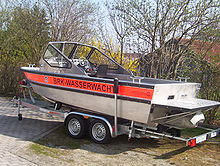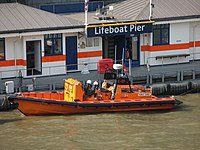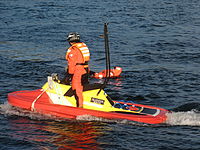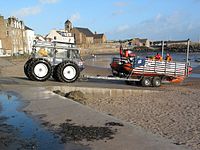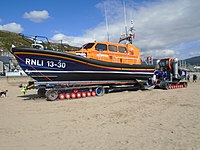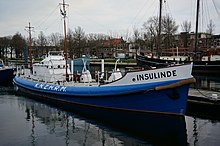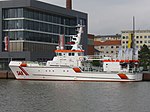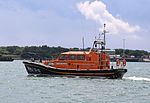Lifeboat
A lifeboat ( RTB ) is a more or less specifically designed watercraft for rescuing people in, by or on the water. In addition, it is also used to provide assistance in ship emergencies in order to avert danger to the health or life of the people on board. Depending on the purpose and area of use, the boats vary in design, size, equipment and drive concept. In principle, the boats can be differentiated based on the area of operation and their operator. In inland areas and on the beaches of the sea, water rescue is carried out by the water rescue companies ( WRG ). The sea rescue companies ( SRG ) operate in the coastal and offshore waters with their special offshore lifeboats.
Terms
Lifeboats must be carried by all ships in an emergency to rescue the crew. This type of lifeboat is covered in a separate article.
In Germany, lifeboats have to meet the design requirements for civil watercraft, which are specified under DIN EN 1914 “ Inland navigation vehicles ”. Many WRG use such boats for their rescue and work assignments. Due to the procurement modalities with grants from federal funds for disaster control , they are also used as disaster control boats ( K-boats ). Special K-boats are the particularly shallow flood boats that can also be used where there is otherwise no water.
For fire brigade lifeboats , the specifications from DIN 14961 “ Boats for the fire brigade ” must be observed, according to which there are two types of lifeboat. The lifeboat type 1 (RTB 1) is only suitable for standing water and has only paddles as a drive. It can be designed for motor operation and must be kept ready for use - i.e. inflated as an inflatable boat. The lifeboat type 2 (RTB 2), which must be equipped with a motor and thus defines the group of motor lifeboats, is used for flowing water. The standard also includes the somewhat larger multi-purpose boats (MZB), which are also suitable for transporting people and for technical assistance. Some of the RTB 2 and MZB have a bow hatch so that people can be taken over safely on the bank.
Most of the terms were and are coined by the SRG. In the early days, the term lifeboat was sufficient, as there were only boats rowed by a crew. With the introduction of motorization , a distinction became necessary, which led to the rowing lifeboat and the motor lifeboat ( MRB ). Many SRGs still refer to their vehicles as motor lifeboats or simply lifeboats ( Swedish räddningsbåt , Danish Søredning båd , French canot de sauvetage ), although these vehicles are designed and equipped very differently than the historical MRBs. The DGzRS calls their smaller RTB lifeboats . In English usage, a lifeboat is called a lifeboat .
The first rescue stations were mostly built on extensive coastal stretches without a port or a river estuary. The lifeboat was therefore housed near the beach and was stored on a trolley so that it could be moved more easily. The transport to and into the water required the arduous deployment of the rescuers and later with harnessed horses. This technique is still used today in beach lifeboats with the help of special tractors .

With the motorization, the range of action of the lifeboats could be extended to the coastal area. As a result, the DGzRS called z. B. the boats developed before the Second World War , coastal lifeboats (example: Rickmer Bock ). In the Netherlands the term of such ships port lifeboat ( Dutch havenreddingboot ), since these 'new' ships could not be set from the beach out to sea because of their size.
The special boats for search and rescue missions in the deep water area far away from the coasts are referred to by the DGzRS as sea rescue cruisers . In Sweden the Sjöräddningssällskapet (SSRS) uses this term ( Swedish räddningskryssare ) and also in Norway at the Redningsselskapet (NSSR) it was used at times ( Norwegian redningskryssere ). The British SRG Royal National Lifeboat Institution (RNLI) calls her ocean-going boats all-weather lifeboat ( English all-weather lifeboat ). In the Netherlands , the Koninklijke Nederlandse Redding Maatschappij (KNRM) adopted this term ( Dutch allweather-reddingboot ), which has also found its way into the French company Société Nationale de Sauvetage en Mer (SNSM) ( French Canot Tous Temps ). In the USA and Canada , the term is consistently for such seagoing boats motor lifeboat ( English Motor Lifeboat ) used.
General
Time factor

The increase in recreational sports on the water has increased the number of water rescue emergencies over the years. The time factor plays a decisive role in all rescue operations, because the faster help arrives at the scene of the accident, the higher the chances of rescue and, if necessary, survival. Strong currents and waves, especially in the open sea, also create the great danger of drifting away , which can make extensive search operations necessary before a rescue. The set-up times and the travel times to the place of use are also decisive. Therefore, a high level of commitment and great speed in general, the A and O in water rescue, because with people in the water threatens very quickly hypothermia with all its consequences.
Alerting
If an emergency situation of people on the water is observed, a report should be made immediately via the pan-European emergency number 112 . This will reach the next rescue control center , which will immediately set the rescue chain in motion. For emergencies on and in the water, qualified WRG or SRG with suitable rescue equipment and qualified rescue personnel are available around the clock ( 24/7 ) so that help can be provided quickly and appropriately.
In the event of emergencies on and off the coast, the Maritime Rescue Coordination Centers (MRCC) are called in. Incoming emergency calls via 112 for such emergencies are forwarded to the responsible MRCC by the receiving control center . For emergencies at sea outside the range of mobile communications, there are separate alarm channels via marine radio or satellite communication that reach the responsible MRCC directly . This is used to alert the sea rescue and coordinate all necessary SAR measures (SAR = Search and Rescue ) with ships and aircraft.
Water rescue services
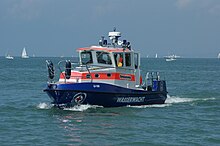
The water rescue service in Germany is supported by the WRG such. B. perceived by the DLRG , the DRK water watch or the special groups of the JUH or the ASB . The fire brigades of the communities with larger parts of the water also have water rescue vehicles for this purpose , which carry a lifeboat. In Austria the auxiliary services ÖWR and ASBÖ are alerted and in Switzerland the SLRG makes this service generally available.
At Lake Constance , sea rescue is organized internationally by the German water police , the Swiss sea police and the Austrian maritime gendarmerie. The Société internationale de sauvetage du Léman has its own rescue company on Lake Geneva .
Other countries have established similar structures for rescuing water in the nation states. In the Netherlands there is the nationwide Reddingsbrigade Nederland , which is mainly responsible for the rescue service on the North Sea coast and on the many inland waters. In Great Britain the Royal Life Saving Society UK takes care of the guarding of the beaches and the training of lifeguards .
In the event of accidents and emergencies on the coast including the open sea, SRG boats are used. In the German coastal area, the Bremen Sea Emergency Line (MRCC Bremen) is switched on and the DGzRS is alerted. Most national states operate their own SRG in order to carry out the internationally defined SAR tasks in their sea areas. All neighboring states are obliged to support each other. Many of the internationally known and renowned companies have been operating since the 19th century. The international WRG and SRG are listed under:
Lifeboats and their areas of use
In the simplest case, a simple rowing boat - as far as it is within reach - is sufficient for water rescue and allows rapid intervention in case of people in need. The clubs active in sailing and rowing usually have a motorboat to support their training and can therefore provide help quickly in such cases - even in the event of 'unfamiliar' accidents or general emergencies on, in or on the water. On the Bavarian lakes, for example, boat owners have launched the Voluntary Sea Emergency Service in order to be able to provide quick help with their boats. However, if a message is sent via 112, a heat recovery system will always be alerted.
A differentiation of the lifeboats can be made based on the area of operation.
- Inland ( English in-land ) with lakes, rivers and canals
- Coastal area ( English in-shore ) with the beaches and the large estuaries
- Coastal seas ( English off-shore ) with the deep water area away from the coasts
In addition, special shapes are required that also cover amphibious areas and can make water surfaces with ice and snow passable.
Inland water lifeboats
Due to the relatively similar conditions on the lakes, rivers and canals inland, the WRG uses largely the same types of boats worldwide. These are mostly open, industrially manufactured motor lifeboats with a solid hull made of plastic or aluminum .
Sometimes simple inflatable boats - also called zodiac - are used. The smallest unit of the fire brigade is the rapid response boat , which can be carried on an rescue vehicle or a rescue group vehicle . When packed together, it weighs 40 to 50 kg and is inflated in a few seconds using a compressed air cylinder . However, it is only suitable for rescue operations close to the shore, as a safety line must be carried along on the shore.
The standardized RTB 1 can also be designed as a dinghy. According to the standard, it must be kept ready for use in the inflated state. For this reason, they are loaded onto a water rescue vehicle or on a separate boat trailer for transport as a roof load in accordance with DIN 14962 " Fire services - boat trailers ". An RTB 1 according to DIN 14961 must also be suitable for ice rescue.
The rigid inflatable boat has found the most widespread use . A circumferential air hose is attached to a light hull made of plastic (e.g. GRP or FKV ) or aluminum as an upper end. With a low weight, the boat is almost unsinkable due to the air-filled tube and can be driven safely even in high waves. In short, these boats are also known as RIB or RHIB as an abbreviation of the English terms. Because of their higher weight and for faster readiness for use, RIBs are transported with a boat trailer or swap-loader vehicle.
Floating 'storage' on rivers and lakes is also practiced so that the boat is ready for use more quickly in an emergency. On the coast, the larger lakes or on particularly endangered river sections, the WRG have set up special water rescue stations that are staffed during the water sports season during the day. As a rule, you have an RTB with an outboard motor that can be used immediately .
The length of the lifeboats in inland use varies between four and seven meters, depending on the location and type of use. The larger boats have partially closed superstructures to accommodate rescued persons below deck. A draft of 70 cm is rarely exceeded. A smaller type of boat (Boston Whaler 13) as a planing boat with an outboard jet drive has a draft of just six centimeters when planing and can therefore land on flat banks.
The WRG are increasingly relying on jet skis , which can travel much faster on the water than traditional lifeboats. Their low weight of approx. 350 kg makes them highly mobile when loaded on a trailer, as they can be brought quickly to almost any location on the water with an all -terrain vehicle or a special quad . To accommodate and rescue swimming people, the boats carry a plastic mattress (rescue board) on which drowning people can hold on. Endangered persons can be quickly pulled out of the danger area without having to be taken into the boat. These special jet skis are officially Rescue Watercraft referred (RWC) and are among the lifeboats in BOS service ( B AUTHORITIES and O rganisations with S icherheitsaufgaben).
Lifeboats for the coastal area
The WRG also perform their tasks on the estuaries of the large rivers, in the near coastal area and in beach guards. Therefore, similar types can be found in this area as in the inland. They are either transported on trailers, are moored on piers or are stored floating in boat houses. Because of the greater stress caused by waves, the designs are more stable and usually have slightly longer lengths, which can be up to 10 meters. Some types of boats have closed superstructures to protect people. The boats are often designed for a larger number of people, as there is frequent passenger traffic in the areas and ships have to be evacuated in an emergency. Such boats can be found, for example, on large inland lakes such as Lake Constance, the Swiss lakes or the IJsselmeer in the Netherlands.
Fast jet skis are also being used more and more frequently on the coasts and beaches to bring surfers or reckless swimmers ashore. A special jet ski is the Rescuerunner developed by the Swedish SSRS , which can reach a speed of 38 knots with a length of 3.60 meters . A rear area of 1.5 m² serves as a transport area for equipment or rescued people.
The SRG are also present in the coastal area and work in cooperation with the WRG. They use smaller and lighter sea rescue boats (SRB), which can also be transportable (beach lifeboats). The standard SRB of the DGzRS are made of sea-weatherproof aluminum as a self- erecting device and offer a closed wheelhouse. The latest development is the all- plastic Rigid Buoyant Boat (RBB), which receives its buoyancy solely from its rigid and light hull and remains buoyant even when it is completely flooded. The RNLI uses such boats on the Thames and the DGzRS has also procured RBB for the lagoon waters of the Baltic Sea .
Nikolaas class of the KNRM on the IJsselmeer
Jet ski on trailer of the Spanish Red Cross
Rescuerunner from Sweden
Mobile beach lifeboats
Beach lifeboats can still be found today, especially on coasts with long stretches of beach such as the Dutch North Sea coast or the German Baltic Sea . They have the advantage of a shallower draft over the large boats. The prerequisite for being able to travel across the beach was and is a low weight, which at the same time results in a shallower draft. Because of this and the faster on-site deployment, they have an advantage over the large boats. Special surf stretchers are required to bring the transport trolleys deep into the surf. Development began in Holland, Germany, England and North America in the 1930s and had to be paid a lot of hard money.
The Dutch KNRM currently owns a RIB of the Valentijn class as a beach lifeboat . The boat with a length of 10.6 meters and an aluminum hull is stored on a special support frame with caterpillar undercarriage in a shed behind the dike near the beach. For use, a tractor on caterpillars pulls the team to the beach and into the water, where the boat can be quickly lowered and set off to sea.
The English RNLI also practices such an operation from land with boats of the Mersey class (length 11.6 meters). The Shannon Launch And Recovery System was specially developed for the latest 13.6-meter-long Shannon-class boats , with which the boat can be rotated 180 degrees on the support frame. This simplifies lowering and retrieving the boat so that it can be cleared for the next mission more quickly. In addition, the RLNI also uses slipways , in which the boat is stored above the waterline and protected from the attack of waves in a shed and slides into the water via a slide.
KNRM Valentijn class with caterpillar tractor
RNLI E-class RIB boat with wheeled tug for water use
RNLI Mersey-class on a tracked vehicle
RNLI Shannon Launch And Recovery System
Lifeboats for offshore operations

Outside protected waters, appropriately designed lifeboats from the national SRG are used. Due to the required stable basic construction, the special weather resistance and the relatively shallow draft, the lifeboats are a special shape and cannot be compared with other ships. In terms of stability and righting ability, in particular , they have a very small ratio of ship length to ship width of three to five - that is, they appear much wider than normal ships. Due to their length of well over ten meters, they are dependent on port infrastructure and are mostly moored near the port entrance so that the boats are ready for immediate use.
The SRB are developed in close cooperation between the national SRG and the shipbuilding industry. Through bilateral or international exchanges between the SRG - e. B. at the conferences of the International Maritime Rescue Federation (IMRF) - you can find similar equipment features in all current SRB. The different versions stem from national circumstances or are determined by other priorities. Nowadays, all modern SRBs have closed superstructures (wheelhouses) in order to provide adequate protection for the crew and the people in the house.
The conceptual differentiation between lifeboats and larger ships also used in rescue operations is not clear. The world's largest special ship, specifically designed for sea rescue, is the sea rescue cruiser " Hermann Marwede " of the DGzRS , with a length of 46 meters , stationed on the island of Helgoland . The sea rescue cruisers built in series by this company have lengths of 20 to 28 meters and are therefore slightly longer than the corresponding vehicles in other countries. This is due to the ' daughter boat ' concept , in which one is carried in a stern tub. This shallow-draft boat is designed for use in shallow waters or to take people out of the water. Other SRG such as B. in the USA or at the KNRM prefer shorter SRB with less draft and lengths under 20 meters.
A special feature are patrol boats that cruise off the coast for a certain period of time in order to be on the spot faster in emergencies. The Norwegian NSSR has practiced this for a long time in order to accompany its fishing fleet on long fishing trips across the North Sea towards Iceland .
Historic boats
see also: History of sea rescue
The beginnings
Records from 1737 tell of a rescue service in China, on the Yangtze lifeboats used brought (16) - consequently some 40 years before the first English constructions. Interestingly, they were already using techniques to revive drowned people.
The first documented rescue station was in England in 1776. Despite the many years of experience with sailing ships, the first rescue associations used rowing lifeboats. Due to the wind independence in storms and the better maneuverability , the rowing boats developed from fishing boats were superior to the sailing boats in the rescue service. Eight to twelve strong rowers gave the boats adjustable and reliable propulsion. They had the same pointy shape at the bow and stern in order to offer little resistance in the surf regardless of direction and not to have to turn around during rescue operations. Sometimes boats were also equipped with auxiliary sails in order to conserve the strength of the rowers on long journeys (p. 20) .
In Paris in 1765, the French Bernières presented a lifeboat that had built in airtight boxes as a buoyancy aid and was therefore described as "unsinkable". The boat was probably ahead of its time and was forgotten. The actual beginning of the construction of lifeboats is dated to the year 1785, when the English inventor and wagon builder Lionel Lukin presented the patented conversion of a Norwegian yawl as an unsinkable lifeboat. It contained cork-filled chambers for buoyancy and a steel keel , which should provide greater stability. The first boat specially designed for rescue operations was built for the ship's carpenter Henry Greathead and tested on the Tyne on January 29, 1790. The boat with the name Original was not yet self-righting but was considered unsinkable and was in service for 40 years. A total of 31 boats of this type were built, eight of which were also exported (p. 89-p. 93) .
In the USA, the inventor Joseph Francis designed and built the first lifeboat in the 1830s, the side walls of which were made of fluted iron. This fluting had the same effect as the clinker construction of the wooden boats, which makes the hull significantly more stable. Similar to the Greathead boats , these were also used successfully in Europe and Canada. The American skipper found on the boats but no favors as they 60% heavier than the existing cedar boats were (p 108) .
As early as 1789, William Wouldhave had presented the model of a lifeboat, which had the special feature of self-righting. However, initially no boat was built according to his specifications. It was not until 60 years later that the RNLI picked up his idea again after suffering some tragic losses of non-self-righting lifeboats. In 1851 she decided to prefer to use a standardized RTB with the principle of self-righting. 30 years later the lifeboat fleet in Great Britain and Ireland consisted of 249 self-righting lifeboats (p.?) .
The detour steam engine
With the development and spread of the steam engine in the 19th century, the idea of using this technology on lifeboats was developed. However, only after smaller, lighter and more powerful machines had been developed, did the RNLI approach such a design. In 1890 the first steam lifeboat Duke Of Northumberland was put into service, followed by five more. The boat was 15.2 meters long, had 15 watertight compartments and was in service until 1923. Other steam-powered lifeboats were also used in the Netherlands , Australia and some British colonies . The functional principle of these vehicles is particularly worth mentioning. The steam engine did not act on a propeller shaft , but drove a pump that sucked in water and then expelled it through pipes below the waterline; This technology is comparable to modern jet propulsion . By controlling these pipes accordingly, the boats could not only be moved conventionally forwards and backwards, but also sideways. However, these advantages did not outweigh the major disadvantages of this type of propulsion: too heavy, too deep and too expensive to maintain because they had to be kept under constant steam.
Motor lifeboats
With the advent of gasoline engines , SRG's interest in this technology increased. Although an Étienne Lenoir had already designed a petroleum-powered boat in 1861 , the breakthrough in this area only came with the developments of Gottlieb Daimler . In 1886, Daimler installed a gasoline engine in a boat that was significantly smaller and required less operation and maintenance. However, the first engines were not powerful enough for use in lifeboats.
In the emerging USA , the development of gasoline engines advanced faster than in Europe. The US Coastal Rescue Service was the first company to venture to equip a boat with a gasoline engine. The prototype presented had many properties that were far ahead of its time and only became standard much later. It had two drive shafts with their own screws, which were still driven by a single motor. The engine itself was in a closed and airtight room (compartment) in the stern of the boat, with all operating and monitoring elements being led outside. This enabled all engine control interventions to be carried out from the open cockpit . The engine drew the necessary air through a valve through an air intake line that was pulled up in front of the engine bulkhead and ended at deck level. Due to this construction, no water should be sucked in when capsizing. The propellers were not in a tunnel as was later introduced, but they had a protective cage against grounding. The propeller blades were interchangeable and adjustable using a wheel in the cockpit (p. 123) . After positive experiences, row lifeboats with petrol engines were retrofitted from 1904 and the first new motor lifeboats were soon built. In 1915 the US Maritime Rescue Service already had 230 motorized units. In contrast to the European organizations, the engine was seen as the primary drive unit for an RTB and sails were only intended as a replacement if the engine failed.
The European SRG dared to take the step to motorize their lifeboats only very cautiously and viewed the motors only as an auxiliary drive in addition to the sails. There were also great doubts about the reliability, as the new technology tended to fail or the engines started poorly. For this reason, for example, only 19 MRB were in service in England in 1918 and thus only 1/16 of the entire fleet. Attitudes towards this only changed in the 1920s with the further development of diesel engines. The elimination of the compressor reduced the weight and the diesel engine showed greater reliability. In 1928, the DGzRS decided to only install this type of engine in the boats.
Another milestone was the construction of the "Insulinde", which was viewed as a radical departure from traditional boat building. The boat, built in 1927 for the Dutch NZHRM (predecessor of KNRM), was the first large self-righting MRB in steel construction. With the help of its 'tilt tanks', the ship was able to bring itself back into the upright position with the keel down after capsizing. It had a floor construction with tunnels for the drive trains and completely separate rooms for the two diesel engines. For the first time, a whale deck was used so that the water that had been taken over could be quickly drained away. A characteristic that the DGzRS only picked up later with the rescue cruisers. This shape and the high ballast weight earned the «Insulinde» the nickname "Ballast Bottle". (P. 135)
At the beginning of the 1950s, the DGzRS became the protagonist of a completely new type of lifeboat and presented the basics for an ocean-going motor lifeboat of the future . She wanted to take into account the foreseeable change in maritime traffic to ever larger ships and shipping lanes far from the coast , taking into account the technical progress in shipbuilding and engine development. Compared to the existing MRB, such a boat should have the following properties:
- unlimited seaworthiness even in extremely bad weather
- at least twice the speed of the previous boats
- Use in both deep and shallow lake and coastal waters
The “Theodor Heuss” , which went into service in 1957 , was a highly regarded, innovative type of ship, the characteristics of which were only adopted later by other SRGs. In order to enable operations in the flat parts of the North and East Seas, the new ship had a daughter boat on board for the first time .
Requirements and design criteria

The retired naval officer Hendrik De Booy was for a long time the board of directors of the Dutch NZHRM and was involved extensively with the design of lifeboats in the 1920s . At one of the IMRF conferences, he spoke about the old principle for designing lifeboats: (p. 135) :
"Die Konstruktion eines Boot muss sich nach den Gegebenheiten richten, für das es vorgesehen ist; sind die Gegebenheiten anders muss auch das Boot anders aussehen.
Therefore, the lifeboats vary in design, size, equipment and drive concept depending on the intended use and the national areas of use. To this end, the WRG draw up requirement profiles in order to obtain the optimal type of boat for them. The SRG in particular have a high share of these requirements, as they also have to cover the deep water areas of the seas outside of the coastal area. A standardization as they would be beneficial not only for cost reasons, is limited in time possible because they can cover all applications only with great circumstances. Most likely, standards should be established for the interior fittings and equipment so that, for example, the communication devices are interchangeable. This is also conceivable with the motors if the 'small' RTB only has one motor of the larger class. The American USCG is furthest in standardization, designing a single type and then building it over the years and putting it into service. Currently, the 47-foot motor lifeboat is the standard boat with 227 copies. It is only supplemented by the fast response boat in order to get to the emergency site quickly at its maximum speed of 42 knots. The Dutch KNRM also operates 'only' three types for use on the North Sea. In contrast, the Norwegian NSSR operates a wide variety of currently 11 types. This is mostly due to the ongoing renewal and improvement of the fleet. The German DGzRS has four types in use over the long term, two of which are individual 'large ships'. Older class ships often serve as replacement vehicles when they are in a shipyard.
The following properties are considered to be important in order to bring help quickly on site in an emergency:
- Unlimited use in all weather and sea conditions
- great speed and long range
- unsinkable and self righting
- safe drive system
- high stability of the ship's hull
- greatest possible safety of the crew
- sheltered accommodation for rescued people
- shallow draft for problem-free use in shallow water areas
In general, the sizes of ships have grown in recent years, at least in terms of the dimensions of the superstructures. The high achievable speed requires more powerful and therefore larger motors. To extend the range beyond the 50-mile limit or for travel times over a day, larger tank capacities must be created. Also to improve the comfort for the crew during long periods of stay on board and the accommodation options for rescued persons below deck leads to larger dimensions.
List of ocean-going rescue units
Selection of current lifeboats with construction time since 2000:
| Society land |
Boat class crew |
Number Boats construction period |
Length width draft |
Displacement (material) |
Motors drive |
Range at (speed) |
photo | Remarks Rescue of persons |
|---|---|---|---|---|---|---|---|---|
|
DGzRS Germany |
46 meter class 7 FA |
1 boat 2003 |
46.0 m 10.66 m 2.80 m |
404 t GT: 300 (aluminum) |
3 engines 9,250 PS F-P |
920 nm (25 kn) 2100 nm (15 kn) |
(Single item) daughter boat |
|
|
DGzRS Germany |
36.5 meter class 5 FA |
1 boat 2012 |
36.45 m 7.80 m 2.70 m |
220 t GT: (aluminum) |
3 engines 6.508 PS F-P |
900 nm (25 kn) 1400 nm (17 kn) |
(Single item) daughter boat |
|
|
DGzRS Germany |
28 meter class 4 FA |
3 boats 2012-2017 |
27.90 m 6.20 m 1.95 m |
120 t GT: (aluminum) |
2 engines 3,916 PS F-P |
600 nm (24 kn) 800 nm (kn) |
Daughter boat | |
|
KNRM Netherlands |
Women SAR 1906 1 FA + 5 FW |
1 boat 2014 |
19.30 m 6.55 m 1.10 m |
33.6t GT: (aluminum / composite) |
2 engines 2,434 PS W-J |
300 nm (31 kn) |
(Prototype) tailgate |
|
|
KNRM Netherlands |
Arie-Visser 1 FA + 5 FW |
10 boats 1999–2009 |
18.80 m 6.10 m 1.03 m |
27.4 t GT: (aluminum) |
2 engines 2,000 HP W-J |
500 nm (34 kn) |
Tailgate | |
|
VLOOT Belgium |
ORC R6 Orca 3–6 people |
1 boat 2014 |
19.60 m 6.14 m 0.95 m |
? t GT: 46 (composite) |
2 engines 1,770 HP W-J |
25 knots RW: sm |
Stern platform | |
|
RNLI United Kingdom |
Shannon class 6 FW |
26 boats 2013– |
13.60 m 4.54 m 0.75 m |
15 t GT: (composite) |
2 engines 1,300 HP W-J |
25 knots RW: 250 nm |
? | |
|
RNLI United Kingdom |
Tamar class 7 FW |
27 boats 2000–2013 |
16.00 m 5.00 m 1.35 m |
32.5 t GT: (composite) |
2 motors 2,000 hp screw |
25 knots RW: 250 nm |
dinghy | |
|
RNLI United Kingdom |
Severn class 6 FW |
44 boats 1992-2005 |
17.00 m 5.50 m 1.38 m |
40 t GT: (composite) |
2 engines 2,500 PS F-P |
25 knots RW: 250 nm |
dinghy | |
|
RNLI United Kingdom |
Trent class 6 FW |
37 boats 1991-2005 |
14.26 m 4.90 m 1.30 m |
27.5 t GT: (composite) |
2 engines 1,640 PS F-P |
25 knots 250 nm (25 kn) |
dinghy | |
|
NSSR Norway |
Ulstein class 3 FA |
3 boats 2015– |
22.0 m 6.26 m 1.2 m |
54 t GT: (aluminum) |
2 engines 3,320 PS W-J |
38 knots 600 nm |
Rescuerunner | |
|
NSSR Norway |
PCG Sundt class 3 FA |
7 boats 2007– |
17.0 m 6.26 m 1.2 m |
27.8 t GT: (aluminum) |
2 engines 2,000 HP W-J |
42 knots 400 nm |
Rescuerunner | |
|
NSSR Norway |
Fosen class 3 FA |
6 boats 2003– |
26.7 m 6.38 m 2.1 m |
95 t GT: (aluminum) |
2 engines 4,000 PS V-P |
29 knots 600 nm |
||
|
USCG United States |
47 foot MLB Class 4 FA |
227 boats 1997– |
14.6 m 4.27 m 1.37 m |
18 t GT: (aluminum) |
2 engines 870 PS F-P |
25 knots 200 nm |
||
|
MSPiR Poland |
SAR-3000 class ? Pers |
3 boats 2010–2012 |
39.9 m 8.1 m 1.1 m |
? t GT 276 (aluminum) |
2 engines 6,690 PS F-P |
24 knots ? sm |
Abbreviations: FA = permanent employees | FW = volunteers | WJ = Waterjet | FP = fixed propeller | VP = controllable pitch propeller
See also
Individual evidence
- ↑ DIN EN 1914: 2016-12 Inland navigation vessels - work boats , auxiliary boats and lifeboats on Beuth.de , accessed on May 23, 2020
- ↑ DIN 14961: 2013-04 Boats for the fire brigade on Beuth.de , accessed on May 23, 2020
- ↑ Boats for the fire brigade working group of the fire brigade accident insurance funds, accessed on March 31, 2020
- ↑ DIN 14962: 2005-02 Fire Service - Boat Trailers on Beuth.de , accessed on May 23, 2020
- ↑ Die Jet-Retter on feuerwehr-ub.de , accessed on May 3, 2020
- ↑ a b c d e f g h [Clayton Evans: Rescue at Sea: An International History of Lifesaving, Coastal Rescue Craft and Organizations ] Conway Maritime Press 2003, ISBN 978-0-85-177934-8
- ↑ Ostersehlte, C .: Sea Rescue and Politics Deutsches Schiffahrtsarchiv, 27, 111–152 (2004)
- ↑ Hans Knarr: Typenkompass Seenotkreuzer Pietsch Verlag (2013) ISBN 978-3-613-50743-2




